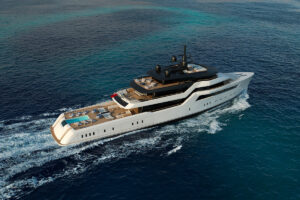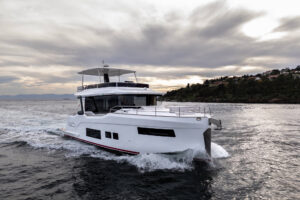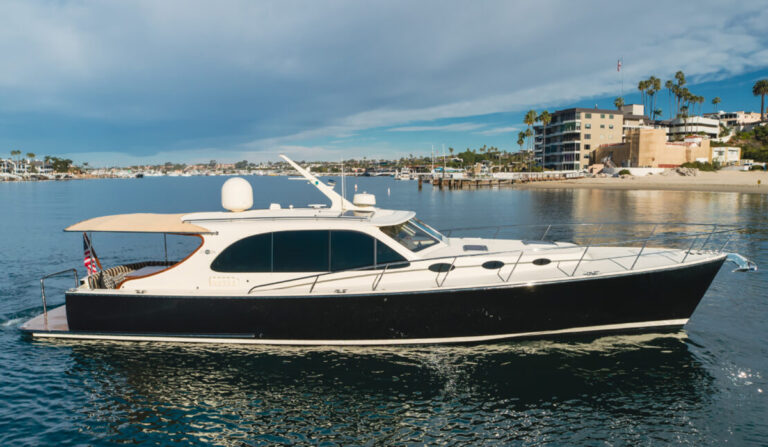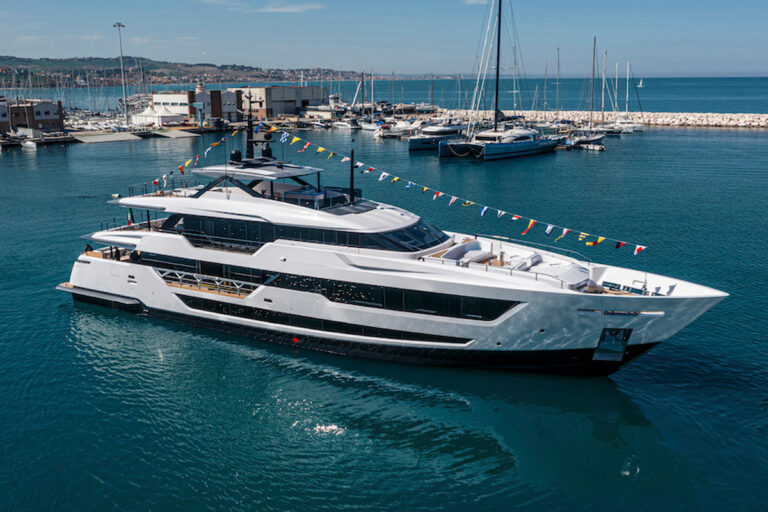Not an early riser by nature, told to be ready for sailing at 0630 hours, lacking breakfast, in truth I hardly cared that the day’s plan was to cruise along Italy’s beautiful Ligurian coast.
Until I beheld the yacht, that is. At 116 feet in length, this was the new flagship of the Azimut range-the yacht that closes the gap between the Azimut production yachts molded in fiberglass and the Benetti superyachts that come from the same stable. It is also one of the first large yachts to emerge from the new building facility that Azimut has established at the “home” of Italian yachting at Viareggio.
And what a facility this is with yachts on the scale of this 116-footer virtually rolling off a production line. Working at that scale, you have to get things right from the start and this 116 has all the right credentials. For the main design work Azimut has used their long-term partner, Stefano Righini; for the interior, Carlo Galeazzi has masterminded the style. The result reflects Italian superyacht elegance at its very best. There is nothing here that will change the world as far as yacht design is concerned but then there is nothing that will go out of fashion quickly. This design is timeless, it is elegant, it is Azimut. Veni Vidi Vinci.
From this galley (also they crew’s mess), food goes directly to a 12-seat dining room table at the far end of the saloon. From the outside this design is more superyacht than production yacht. The confident sweep of the profile is emphasized by the teak-capping on the low bulwarks and the imperious superyacht style of the rails. The profile sweeps up, first to the pilothouse windows and then on to the flybridge where an arch mast supports fixed bimini tops that extend both fore and aft. These provide effective shade over the flybridge; large panels can be opened up to the sun.
The long run of the flybridge caters to every relaxing need. Toss your prawns on the barbecue, handy to the bar counter. Toss yourself on one of the sun beds surrounding a Jacuzzi pool. Fling yourself overboard-at the appropriate time and place, that is-via the diving board fastened to the rails for those who want to take to the sea in style. Settees and teak tables offer options for alfresco dining. The top helm tucked into the port corner puts the captain within sociable reach, and has all the equipment required for the control of this yacht.
The main control center is just below in the workmanlike pilothouse. It is a measure of Azimut’s seductions that in order to reduce the risk of falling asleep on watch there is no captain’s chair. The angled wheel is flanked by an extensive array of screens that provide all the information for monitoring, control and navigation, run through a central touch screen. Putting all a yacht’s systems on one screen is a growing trend-one that the jury will be out on for awhile yet-but it is a development on which Azimut is way out in front.
On a more traditional note there is a proper chart table in the pilothouse that can also serve as an office. A settee for guests is finished in the same tan leather that decorates the area around the helm. At the rear, stairs lead down to the starboard side main vestibule where you see the true quality of the interior. The carefully crafted cherry wood paneling and moldings have a matte finish and marble inserts have been let into the wooden deck. The vestibule leads forward to a cinema equipped with deep lounging settees but this forward area can also be specified as the owner’s suite, an option that is aimed specifically at the U.S. market because it allows a much more extensive crew area below.
Between the cinema and the saloon there is the galley and the entrance to the crew quarters. Here the mood changes to limed oak paneling and more practical finishes but the quality remains. The well-equipped galley leads into a serving pantry that also acts as the crew’s mess room. From here food can go straight onto the 12-seater dining table that fills the forward end of the saloon.
In the saloon, comfort is king, and quality reigns. The lounge settee, sweeping round on the port side with a couple of low tables for drinks, faces the panel TV that rises from the sideboard opposite. A curved bar has been fitted into the starboard corner, served by four bar stools.
The 116 has two cabin areas, both accessed from the vestibule. One comprises the master stateroom and two double cabins, and another has two twin cabins. (If the main deck master stateroom option is exercised then these staterooms become larger.) The style is similar to that in the saloon but with a more extensive use of fabric on the walls to give a softer image. In the double cabins the beds are angled while in the twin cabins there is a third Pullman berth that can be lowered, suggesting that these are aimed primarily for children. All of the cabins have en suite bathrooms completed in marble and wood.
The master stateroom is a delight. Its triple large oval ports on both sides give natural light; these opening ports are large enough to provide an airy atmosphere-or an escape route, though it might be rather a wet one. A walk-in closet and the large bathroom separate this area from the engineroom, but this does not dull the high-pitched whine that appears to emanate from the gearbox. This noise intrudes on what would otherwise be an oasis of peace and I measured 85 dB(A) in the master bathroom compared with the 63 found in the pilothouse at full speed. Azimut says they are installing more insulation to sort out this problem and no doubt ZF will get on top of the gearbox noise.
Among the other possibilities for dining and relaxing on this yacht is the aft cockpit where there is a large inlaid teak table with matching settee and steamer chairs. A separate bar serving this area can be equipped with a barbecue. Steps lead down on each side to the narrow swim platform, which tucks down when the large garage door folds outwards for boat launching. The garage houses a Sea-Doo boat and two jet skis; the boat and one jet ski have their own launching ramps.
This garage also houses some of the auxiliary machinery such as the watermaker and the hot water boiler. The remaining auxiliaries are in the engineroom where there is a Kohler generator on each side. The thing that really grabs your attention in this compartment is the huge stainless steel exhaust silencer that sits on top of each engine, with the 16-cylinder MTU diesels looking quite small by comparison.
The 4,000 hp of these engines gives this sturdy yacht a top speed close to 24 knots with a comfortable cruising speed of 20 knots. The performance is stately and we took four hours to cruise up the coast from Viareggio to Genoa. It was a relaxing time with very low noise levels in the pilothouse and the rolling firmly under control with the Trac stabilizers. With these switched off you could really see the difference in motion created by the lively seas that were marching up from the south. Running in a yacht with stabilizers does take some getting used to because while they virtually eliminate the rolling, they do seem to add a jerkiness to the motion that does not exist when the stabilizers are off.
On the run up the coast, the land was a misty blue in the early morning Mediterranean light. Traveling in considerable comfort, we passed Carrara, source of the beautiful marble found on board. Then it was on past La Spezia and Cinque Terre before Portofino and St. Marguerita loomed up. It was a voyage past some of the most beautiful parts of the Italian coastline and we were in a yacht that seemed in complete harmony with the scenery and the history of the region, a yacht that featured the shipbuilding craftsmanship that has existed here for centuries.
This was sea travel in real style with the 116 providing all the luxury and comfort you could desire. It is a motoryacht that feels reassuringly safe in the Mediterranean environment and it looks like one that will transfer well to U.S. waters.
Contact: Azimut Yachts, (O11) 39 01193161; www.azimutyachts.net.









